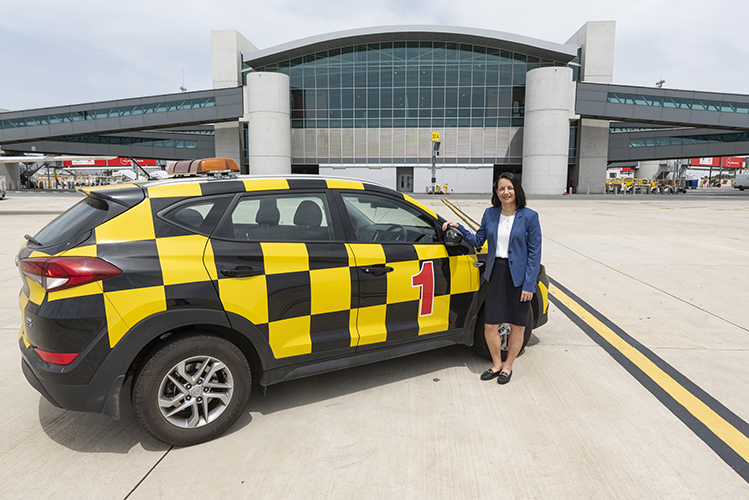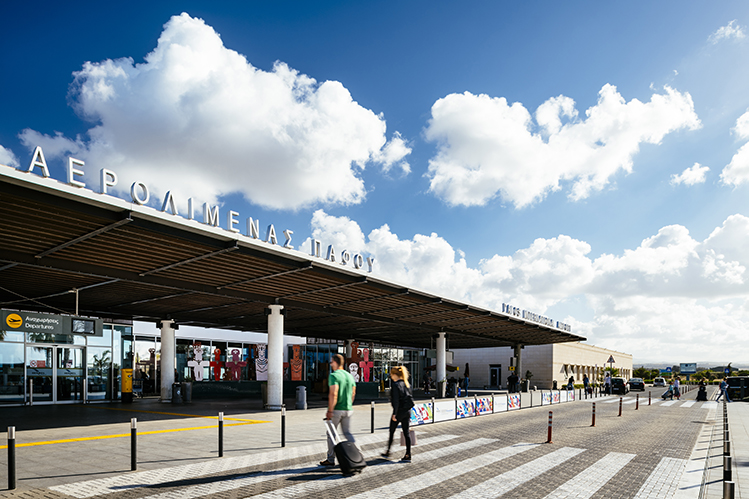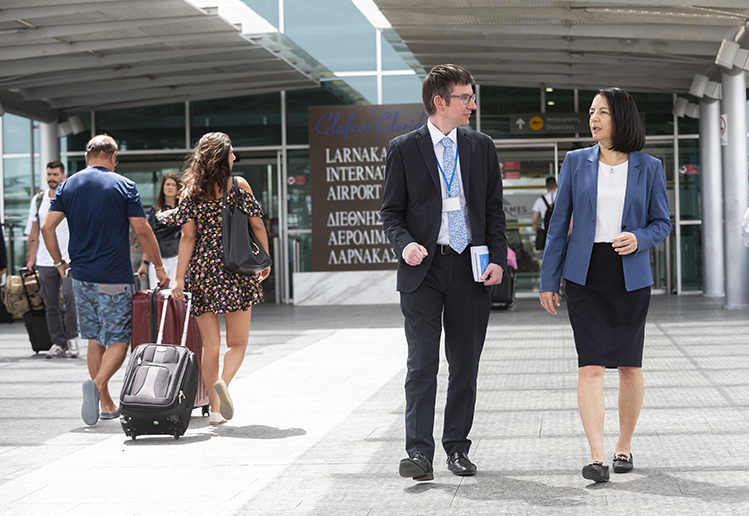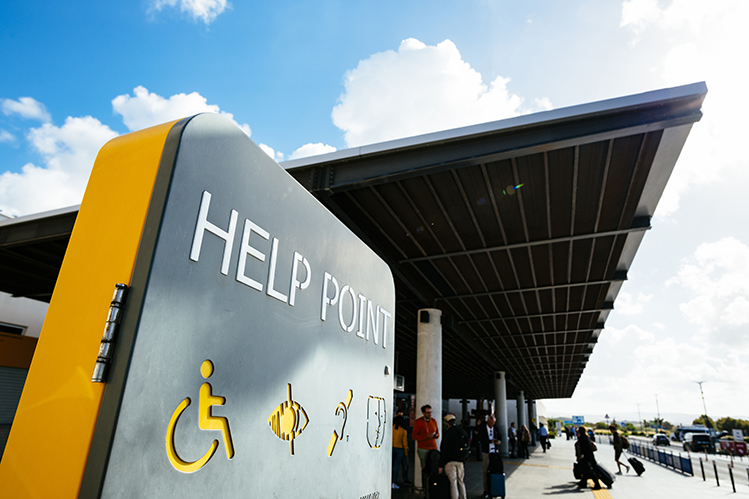An interview with Eleni Kaloyirou, CEO Hermes Airports. By Ross Falconer
Cyprus – ‘The Island of Aphrodite’ – is a vibrant mix of compelling culture and Mediterranean landscapes, and a tourist hotspot, enjoying 300 days of sunshine and welcoming four million visitors annually.
Hermes Airports manages Cyprus’ two gateways – Larnaka and Pafos – which together handle 11 million passengers a year and are experiencing sustained growth (+4.7% in Q1 2019).
Leading Larnaka and Pafos through this period of growth is Eleni Kaloyirou, CEO of Hermes Airports. She joined the company in 2014 as Executive Manager Business Control and then CFO, subsequently taking the helm as CEO in 2016. This followed a background in finance and a 20-year career with Cyprus Airways. After studying economics and qualifying as a Chartered Accountant, Kaloyirou worked for KPMG in London, where she became a banking specialist.
“I have to admit though, I was always interested in travelling,” she begins. “One of my early ambitions was to visit all the countries in the world, or as many of them as I could manage. In a fortunate twist of fate, after qualifying as a Chartered Accountant and returning to Cyprus, the national carrier, Cyprus Airways, needed a finance person and I could not refuse the challenge of working within my area of expertise, in a field that was so close to my heart. This is how my career in aviation began, which developed into a passion for the sector over the years.”

Eleni Kaloyirou, CEO Hermes Airports: “Hermes Airports through its operation contributes 4% to the country’s GDP every year. The airports are a major part of the wellbeing of the island, and the numbers speak for themselves. It is estimated that for every additional flight that arrives at the two Cyprus airports, around 100 additional jobs are created.”
Beginning our interview in Kaloyirou’s office, we take in the panoramic views of the airfield. A Rossiya Airlines 747 with a special livery featuring the face of a Siberian tiger on the nose is parked at the gate nearest to us. Seeing this Kaloyirou remarks she is currently planning her very first trip to Russia – now the airport company’s second-biggest national market.
We are meeting on a typically very busy day for Kaloyirou. After our interview, she travels straight to the capital Nicosia for a meeting with the Cypriot government. Cyprus recently appointed its first dedicated Minister of Tourism, and Hermes Airports works in close partnership with government and all tourism stakeholders to promote Cyprus as a year-round destination.
Every flight worth 100 jobs
Earlier, as we had landed at Larnaka, we could see this very much for ourselves: The crystal-clear Mediterranean water, popular and pristine beaches, and many new hotels under construction. The airport, just 4km from downtown Larnaka, is a vivid picture of the economic importance of the country’s tourism, which is sometimes called the first industry of Cyprus.
“It certainly is heavy lifting, contributing 14% to the country’s GDP, and it was the tourism industry which enabled the country to recover swiftly from the financial crisis of 2013,” says Kaloyirou. “Hermes Airports through its operation contributes 4% to the country’s GDP every year. The airports are a major part of the wellbeing of the island, and the numbers speak for themselves. It is estimated that for every additional flight that arrives at the two Cyprus airports, around 100 additional jobs are created. Over 18,000 jobs at Larnaka and Pafos airports, and in the wider tourism industry, are sustained by the operation of the airports.”
Eleni Kaloyirou curriculum vitae
Eleni Kaloyirou became CEO of Hermes Airports in May 2016, having previously held the position of CFO and Executive Manager Business Control since joining the company in 2014.
She has over 25 years of work experience mainly in the airline industry, in the position of CFO and then deputy CEO of Cyprus Airways. She also has experience in the property development business and the accounting profession having worked for KPMG in Cyprus and London.
Five years, 4 million passengers, 55% growth
Cyprus’ connectivity has developed significantly over recent years, with 70 airlines now operating to 120 destinations in 40 countries. This is the result of Hermes Airports’ proactive air service development strategy, through which it has established long-term partnerships with airlines and tour operators, introduced incentive schemes, and promotes Cyprus together with airlines and other stakeholders.
“The result is 55% cumulative growth in passenger traffic over the past five years, and four million additional passengers,” Kaloyirou explains. “A significant part of this growth was recorded during the winter months, which is also one of the main strategic objectives of the company in order to reduce seasonality.”
2018 saw another record year with 10.94 million passengers (+6.7%), and the growth trend has continued into 2019. Building on that, the aim is to enhance connectivity beyond Europe and the Middle East to destinations in North America and Asia.
Indeed, Hermes Airports is hosting this year’s ACI EUROPE Annual Assembly & Congress, 25-27 June, where a key theme is sustainable tourism. “Synergies between airports, airlines and destinations are a crucial element in the promotion of sustainable tourism,” says Kaloyirou. “Hermes Airports places emphasis on the promotion of the destination in order to build demand, and has created partnerships with airlines under the direct marketing umbrella, through which targeted campaigns generate leads with existing and new passengers. The target is to achieve long-term and sustainable route operation.”
Gender diversity
Hermes Airports takes pride in being among the leading companies in Cyprus in creating a positive organisational culture for all employees. Women make up 47% of the Hermes Airports’ workforce, while 36% of the senior management team are female.
“I never felt different to anyone else because of my gender while progressing in my career,” says Eleni Kaloyirou, CEO Hermes Airports. “Today, I can say that when I sit around the table with my colleagues, industry stakeholders or customers, I never think about their gender. We are all here to do our job, in the best possible way.”
Developing effective leaders should be a strategic priority for any organisation, as the leadership group has significant impact on the performance of the organisation and its culture. “The knowledge, way of thinking, problem solving capabilities and management style of women are accepted as having a valuable contribution to the development of the business,” says Kaloyirou.
She comments that airports, much like other businesses, are increasingly acknowledging the importance of women and avoid differentiating between the sexes. “Personally, I never thought that women should be treated as different to men. As CEO of Hermes Airports, one of the biggest companies in Cyprus, I believe that creating equal opportunities for women is not only a matter of gender equality but also an economic priority.”
Changing trends in improving the passenger experience
We take the opportunity to tour the Larnaka Airport terminal, conducting our interview amidst enterprising commercial areas that themselves are undergoing an 18-month transformation. The feel is of modern, redesigned retail and food & beverage, which fuses globally-recognised brands with a true taste of Cyprus. A defined walkway is taking shape, which will provide natural wayfinding through the space to facilitate passenger flow. A similar redesign will take place in Pafos, starting as the work at Larnaka nears completion in 2020.
The commercial developments are just one element of continuous efforts to enhance passenger experience and flows through the airports. “This is a reflection of changing trends in passenger processing, as well as shifts in regulatory requirements, particularly in areas such as security,” Kaloyirou explains. “Works that have been carried out, or are in progress, include upgrade of the Hold Baggage Screening system to meet the new ECAC Standard 3, which has recently been completed in Larnaka and will be undertaken in Pafos before the end of this year.”
Other developments include the addition of CT scanning technology for cabin baggage screening, enabling laptops and liquids to be screened without being removed from the passenger’s bag; eight new check-in counters and four new bus gates at Larnaka; new security screening lanes at Larnaka and Pafos; and redesign of Larnaka’s apron space to create more aircraft stands.
Also under consideration is the introduction of bag drop facilities at both airports, and the increase of mobile check-in kiosks. Meanwhile, in the area of immigration and security, Hermes Airports is considering expanding the use of the BorderXpress kiosks, which were introduced last year.
“Achieving operational excellence and improving the customer experience are among our key strategic priorities and, of course, technology plays a key role in helping us attain both,” says Kaloyirou. “We are considering a lot of technological advancements – some new, some already tried at other airports – which we are evaluating based on our own airports’ requirements, emanating from the fact that we serve 70 different airlines each with their own needs and expectations.”
Energy: 25-30% from renewables
While growing, Hermes Airports is firmly committed to sustainability. Indeed, it is embedded in the company’s mission statement: “To serve our customers by operating innovative, safe and efficient airports in an environmentally friendly and socially responsible manner”.
Within this framework, it aims to introduce solar plants at both airports this year, which will provide 30% of energy requirements from renewable sources at Pafos and 25% at Larnaka.
Significantly, just a few days after our interview, Hermes Airports received news that it has achieved Level 3+ Neutrality of ACI’s Airport Carbon Accreditation.

Hermes Airports is firmly committed towards sustainability initiatives. It aims to introduce solar plants at both airports this year, which will provide 30% of energy requirements from renewable sources at Pafos and 25% at Larnaka.
Another important project this year is the implementation of a Noise Management System for Larnaka Airport. The system will also include mobile devices that can be used in Pafos when required.
“At the same time, in the framework of the broader sustainability strategy, Hermes Airports is working within the UN Sustainable Development Goals 2030 Agenda by implementing a series of initiatives focused on the environment, sustainable development, quality education, zero hunger, partnerships and others, with particular focus on projects impacting the communities neighbouring our two airports,” Kaloyirou adds.
Hermes Airports factbox
2018: 10.94 million pax (Larnaka 8.07 million, Pafos 2.87 million)
2018 passenger traffic growth: 6.7%
Q1 2019 passenger traffic growth: 4.7%
Number of routes: 120
Key airline customers (Larnaka): Aegean Airlines, Wizz Air, Rossiya Airlines, Blue Air, Cyprus Airways, easyJet
Key airline customers (Pafos): Ryanair, easyJet, TUI, Jet2.com
Top 3 destinations (Larnaka): Athens, Moscow, Tel Aviv
Top 3 destinations (Pafos): London, Manchester, Tel Aviv
“Individualising each passenger’s journey”
Hermes Airports takes a similarly progressive approach to digital communication. It is active across social media, posting daily content on Facebook (60,000 ‘likes’), Twitter (13,000 followers), LinkedIn and Instagram.
Kaloyirou explains that the social media strategy is based on three main pillars: promotion of the airports’ services, supporting airline partners through promotion of their services and offers, and promoting Cyprus as a destination. “The success of our digital strategy is evident by the continuously growing numbers of fans and followers on all social media platforms. During 2019, we also aim to introduce real time communication with passengers, which will include commercial and operational information sharing, in order to further improve and individualise each passenger’s journey through the airports.”
Hermes Airports has also upgraded its website, with a responsive design based on the latest Web Content Accessibility Guidelines, making it accessible to people with disabilities.
A new website for Hermes Airports’ magazine will also be launched soon, through which the company will promote Cyprus through the eyes of locals, and provide ongoing updates on events and things to do in Cyprus.
“At the same time, we have initiated a ‘Sense of Place’ project, which we expect to roll out over a three-year period, giving passengers travelling through both airports a unique sense of what Cyprus looks and feels like, projecting local nature, history, culture and tradition,” says Kaloyirou.
Indeed, as we continue our stroll through the Larnaka terminal, Kaloyirou points out several pieces of Cypriot art, which punctuate the traveller’s journey.

Eleni Kaloyirou, CEO Hermes Airports, explained to Airport Business’ Ross Falconer that the company has initiated a
‘Sense of Place’ project, “giving passengers travelling through both airports a unique sense of what Cyprus looks and feels like, projecting local nature, history, culture and tradition.”
Award-winning accessibility
Hermes Airports is committed to providing high-quality customer services to all passengers. Indeed, Pafos Airport won the ACI EUROPE Accessible Airport Award in 2018 – Larnaka Airport won the award in 2017!
Kaloyirou explains that the company takes a holistic approach to its accessibility strategy, combining the introduction of new technologies, improvement of existing infrastructure, and a high level of care by dedicated staff. “We work very closely with local disability organisations and, having built a relationship of trust and mutual respect, we are able to better understand their needs, resulting in more effective services and initiatives to meet their requirements and expectations.”
Services offered cover the entire end-to-end travel experience, starting in the car parks where lower height payment machines provide easy accessibility. All persons with reduced mobility (PRMs) are offered priority check-in, boarding pass control (e-gates), immigration, security screening, and aircraft boarding.
“A dedicated Changing Place is on offer in Larnaka and we plan to offer one in Pafos soon,” says Kaloyirou. “This facility is separate to our fully accessible toilets and is designed as a restroom equipped with a hoist and a height adjustable changing bed to provide sanitary accommodation and changing/washing/toilet facilities for people with multiple and complex disabilities who have one or two assistants.”
Other recent improvements include the introduction of ‘Roommate’, a way-finding electronic device installed in a PRM toilet at Larnaka Airport to provide audio guidance to people with visual impairments. Meanwhile, the Blind Paths at Larnaka and Pafos are being reconstructed based on the Guardian Tactile System to guide travellers from the designated points of arrival/pick-up for PRMs to the dedicated Assistance Desk.
“We also recently added fully accessible BorderXpress kiosks, used for self-service immigration control,” Kaloyirou adds.

Hermes Airports takes a holistic approach to its accessibility strategy, combining the introduction of new technologies, improvement of existing infrastructure, and a high level of care by dedicated staff.
Hidden disabilities and the ‘I Can Fly’ programme
Supporting travellers with hidden disabilities is another key element of the accessibility strategy. Hermes Airports is supporting people with autism and their families through the ‘I Can Fly’ programme, which was launched a year ago.
“Caring for people with disabilities is most commonly associated with assisting people in a wheelchair, yet fewer than 1 in 10 disabled people use a wheelchair,” Kaloyirou explains. “Think of people with autism, epilepsy, low vision, hearing impairment, heart problems, and many others we meet in everyday life who have no visible signs of a disability. We worked closely with the association of friends and relatives of autistic people – Together for Autism – to develop a dedicated programme addressing autistic people’s needs, fears and specific requirements.”
With the use of a distinctive blue hat bearing the ‘I Can Fly’ logo, airport authorities recognise travellers with autism and offer priority. 240 passengers with autism have so far used the programme. In recognition of its initiatives for people with autism, Hermes Airports has been made an honorary member of the ‘Together for Autism’ organisation.
Kaloyirou emphasises that effective customer service is based on well-trained and motivated employees. Over the past two years, Hermes Airports has won numerous awards for Human Resources management and development, including Platinum Investors in People accreditation (2019-2021), as well as being highly commended in ACI EUROPE’s HR Excellence Award category in 2018.
“Continuous learning and development is a significant area we have focused on,” says Kaloyirou. “We have developed the Hermes Academy, where training is provided on a holistic learning structure based on individual developmental needs. Focus on our people is a key strategic priority, and we consider the results achieved to date a step in the right direction – a direction we intend to continue pursuing.”
As our interview draws to a close, Kaloyirou’s genuine passion for the industry is clear. “I think it is a unique privilege to be able to work in the airport business, where what we do impacts so many lives, both directly and indirectly, and particularly because our airports are so closely related with our island country’s tourism sector. I feel a great sense of responsibility in delivering our vision of operating best-in-class airports with a unique Cypriot sense of place. For the remainder of 2019 and beyond, we will continue along the path we have designed, implementing our strategic priorities in order to be able to deliver our vision, which will be Hermes’ legacy.”







